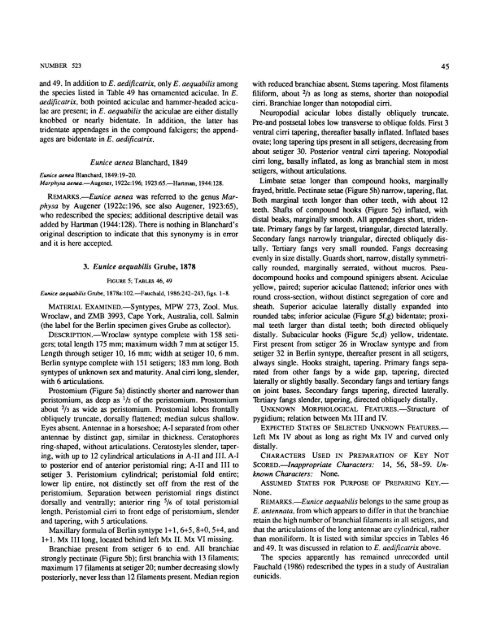A Review of the Genus Eunice - Smithsonian Institution Libraries
A Review of the Genus Eunice - Smithsonian Institution Libraries
A Review of the Genus Eunice - Smithsonian Institution Libraries
You also want an ePaper? Increase the reach of your titles
YUMPU automatically turns print PDFs into web optimized ePapers that Google loves.
NUMBER 523 45<br />
and 49. In addition to E. aedificatrix, only E. aequabilis among<br />
<strong>the</strong> species listed in Table 49 has ornamented aciculae. In E.<br />
aedificatrix, both pointed aciculae and hammer-headed aciculae<br />
are present; in E. aequabilis <strong>the</strong> aciculae are ei<strong>the</strong>r distally<br />
knobbed or nearly bidentate. In addition, <strong>the</strong> latter has<br />
tridentate appendages in <strong>the</strong> compound falcigers; <strong>the</strong> appendages<br />
arc bidentate in E. aedificatrix.<br />
<strong>Eunice</strong> aenea Blanchard, 1849<br />
<strong>Eunice</strong> aenea Blanchard, 1849:19-20.<br />
Marphysa aenea.—Augcner, 1922c:196; 1923:65.—Hartman. 1944:128.<br />
REMARKS.—<strong>Eunice</strong> aenea was referred to <strong>the</strong> genus Marphysa<br />
by Augener (1922c: 196, see also Augener, 1923:65),<br />
who redescribed <strong>the</strong> species; additional descriptive detail was<br />
added by Hartman (1944:128). There is nothing in Blanchard's<br />
original description to indicate that this synonymy is in error<br />
and it is here accepted.<br />
3. <strong>Eunice</strong> aequabilis Grube, 1878<br />
FIOURE 5; TABLES 46,49<br />
<strong>Eunice</strong> aequabilis Gmbc, 1878a:102.—Fauchald. 1986:242-243, figs. 1-8.<br />
MATERIAL EXAMINED.—Syntypes, MPW 273, Zool. Mus.<br />
Wroclaw, and ZMB 3993, Cape York, Australia, coll. Salmin<br />
(<strong>the</strong> label for <strong>the</strong> Berlin specimen gives Grube as collector).<br />
DESCRIPTION.—Wroclaw syntype complete with 158 setigers;<br />
total length 175 mm; maximum width 7 mm at setiger 15.<br />
Length through setiger 10, 16 mm; width at setiger 10, 6 mm.<br />
Berlin syntype complete with 151 setigers; 183 mm long. Both<br />
syntypes <strong>of</strong> unknown sex and maturity. Anal cirri long, slender,<br />
with 6 articulations.<br />
Prostomium (Figure 5a) distinctly shorter and narrower than<br />
peristomium, as deep as x li <strong>of</strong> <strong>the</strong> peristomium. Prostomium<br />
about 2 /3 as wide as peristomium. Prostomial lobes frontally<br />
obliquely truncate, dorsally flattened; median sulcus shallow.<br />
Eyes absent. Antennae in a horseshoe; A-I separated from o<strong>the</strong>r<br />
antennae by distinct gap, similar in thickness. Ceratophores<br />
ring-shaped, without articulations. Ceratostyles slender, tapering,<br />
with up to 12 cylindrical articulations in A-I I and III. A-I<br />
to posterior end <strong>of</strong> anterior peristomial ring; A-I I and III to<br />
setiger 3. Peristomium cylindrical; peristomial fold entire;<br />
lower lip entire, not distinctly set <strong>of</strong>f from <strong>the</strong> rest <strong>of</strong> <strong>the</strong><br />
peristomium. Separation between peristomial rings distinct<br />
dorsally and ventrally; anterior ring s /6 <strong>of</strong> total peristomial<br />
length. Peristomial cirri to front edge <strong>of</strong> peristomium, slender<br />
and tapering, with 5 articulations.<br />
Maxillary formula <strong>of</strong> Berlin syntype 1+1,6+5,8+0, 5+4, and<br />
1+1. Mx III long, located behind left Mx II. Mx VI missing.<br />
Branchiae present from setiger 6 to end. All branchiae<br />
strongly pectinate (Figure 5b); first branchia with 13 filaments;<br />
maximum 17 filaments at setiger 20; number decreasing slowly<br />
posteriorly, never less than 12 filaments present. Median region<br />
with reduced branchiae absent. Stems tapering. Most filaments<br />
filiform, about 2 /3 as long as stems, shorter than notopodial<br />
cirri. Branchiae longer than notopodial cirri.<br />
Neuropodial acicular lobes distally obliquely truncate.<br />
Pre-and postsetal lobes low transverse to oblique folds. First 3<br />
ventral cirri tapering, <strong>the</strong>reafter basally inflated. Inflated bases<br />
ovate; long tapering tips present in all setigers, decreasing from<br />
about setiger 30. Posterior ventral cirri tapering. Notopodial<br />
cirri long, basally inflated, as long as branchial stem in most<br />
setigers, without articulations.<br />
Limbate setae longer than compound hooks, marginally<br />
frayed, brittle. Pectinate setae (Figure 5h) narrow, tapering, flat.<br />
Both marginal teeth longer than o<strong>the</strong>r teeth, with about 12<br />
teeth. Shafts <strong>of</strong> compound hooks (Figure 5e) inflated, with<br />
distal beaks, marginally smooth. All appendages short, tridentate.<br />
Primary fangs by far largest, triangular, directed laterally.<br />
Secondary fangs narrowly triangular, directed obliquely distally.<br />
Tertiary fangs very small rounded. Fangs decreasing<br />
evenly in size distally. Guards short, narrow, distally symmetrically<br />
rounded, marginally serrated, without mucros. Pseudocompound<br />
hooks and compound spinigers absent. Aciculae<br />
yellow, paired; superior aciculae flattened; inferior ones with<br />
round cross-section, without distinct segregation <strong>of</strong> core and<br />
sheath. Superior aciculae laterally distally expanded into<br />
rounded tabs; inferior aciculae (Figure 5f,g) bidentate; proximal<br />
teeth larger than distal teeth; both directed obliquely<br />
distally. Subacicular hooks (Figure 5c,d) yellow, tridentate.<br />
First present from setiger 26 in Wroclaw syntype and from<br />
setiger 32 in Berlin syntype, <strong>the</strong>reafter present in all setigers,<br />
always single. Hooks straight, tapering. Primary fangs separated<br />
from o<strong>the</strong>r fangs by a wide gap, tapering, directed<br />
laterally or slightly basally. Secondary fangs and tertiary fangs<br />
on joint bases. Secondary fangs tapering, directed laterally.<br />
Tertiary fangs slender, tapering, directed obliquely distally.<br />
UNKNOWN MORPHOLOGICAL FEATURES.—Structure <strong>of</strong><br />
pygidium; relation between Mx III and IV.<br />
EXPECTED STATES OF SELECTED UNKNOWN FEATURES.—<br />
Left Mx IV about as long as right Mx IV and curved only<br />
distally.<br />
CHARACTERS USED IN PREPARATION OF KEY NOT<br />
SCORED.—Inappropriate Characters: 14, 56, 58-59. Unknown<br />
Characters: None.<br />
ASSUMED STATES FOR PURPOSE OF PREPARING KEY.—<br />
None.<br />
REMARKS.—<strong>Eunice</strong> aequabilis belongs to <strong>the</strong> same group as<br />
E. antennata, from which appears to differ in that <strong>the</strong> branchiae<br />
retain <strong>the</strong> high number <strong>of</strong> branchial filaments in all setigers, and<br />
that <strong>the</strong> articulations <strong>of</strong> <strong>the</strong> long antennae are cylindrical, ra<strong>the</strong>r<br />
than moniliform. It is listed with similar species in Tables 46<br />
and 49. It was discussed in relation to E. aedificatrix above.<br />
The species apparently has remained unrecorded until<br />
Fauchald (1986) redescribed <strong>the</strong> types in a study <strong>of</strong> Australian<br />
eunicids.
















